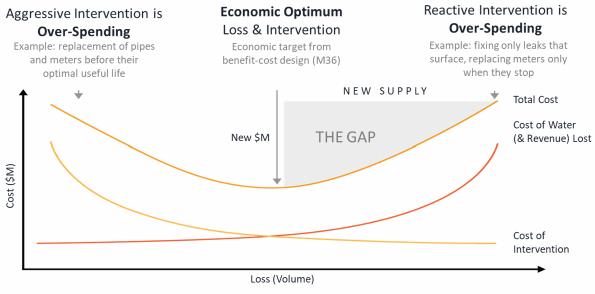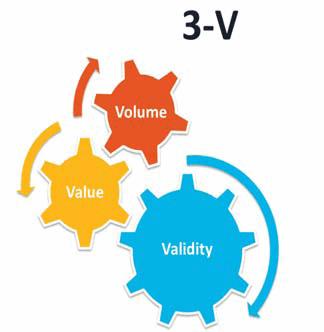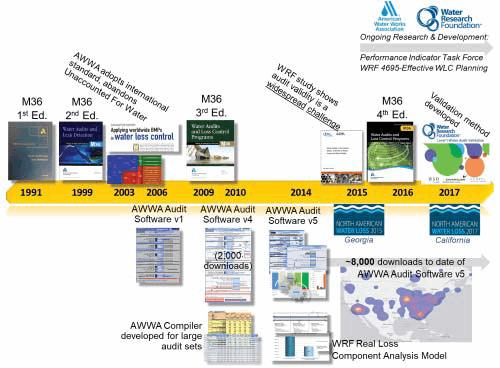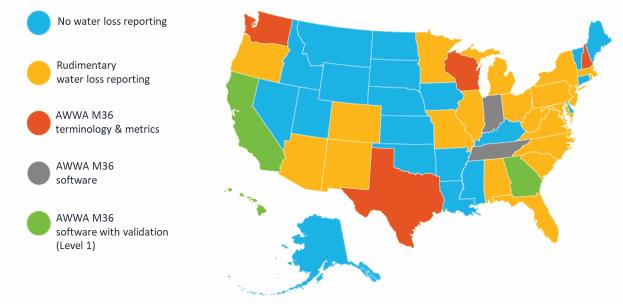The Next Wave Of Water Loss Management In North America
By Will Jernigan
Though the field of water loss management is ever-growing and refining, a validated water audit to disaggregate volumes and values of all loss components remains the essential first step to reduce water loss in a way that is economically sustainable, both for your utility and your ratepayers. With extreme weather events, conservation rate structures, and regional population shifts changing the face of business as usual, it’s time to get with the program.
It’s an exciting time to be in water loss management. In its basic sense, water loss is a resource opportunity waiting to happen. The culmination of the last 25 years has taken water loss from an afterthought to a driving force for policy and management in water utilities across North America. We sit today on the cusp of widespread adoption of standard annual water auditing, validation, and economically driven water loss programs. The AWWA Free Water Audit Software (now in its fifth generation) recently turned 10 years old, and the current version, at over 8,000 downloads, has far eclipsed its predecessor (2,000 downloads). AWWA’s M36 Water Audits and Loss Control Programs manual recently came out in its fourth edition; interestingly, the first edition (1991) of this anchor reference manual was entitled Water Audits and Leak Detection — a testament to how far the industry has come. In fact, AWWA’s water loss brain trust, the Water Loss Control Committee (WLCC), bore this same name as its original moniker. George Kunkel is an integral member of the WLCC and former longtime manager of Philadelphia’s water loss program (the longest-running in the U.S.). George was an inaugural member of the committee in 1991, rumored to have showed up and asked so many questions that they made him the committee chair. A lot has happened in subsequent years, and the WLCC has largely been the driving force.

Figure 1. AWWA M36 concept of economic optimum
Then And Now
Fast-forward to 2017. Multiple states around the U.S. are adopting the AWWA M36 standard. Presently, regulations in 11 areas (California, the Delaware River Basin, Georgia, Hawaii, Indiana, New Hampshire, Pennsylvania, Tennessee, Texas, Washington, and Wisconsin) require utilities to report water loss with AWWA M36 terminology. Water Research Foundation (WRF) projects have proven out widespread challenges with audit data reliability and have established formal guidelines for water audit validation. Those widespread challenges, by the way, have very little to do with direct human error. While there will inevitably be a miscalculation here and there and an everimproving understanding of the basic audit process, the WRF studies suggest that “getting the math wrong” is not what we are up against. The water industry is staffed with highly competent professionals with whom we entrust our public health. What we are up against is systematic gremlins that endeavor to introduce error into the underlying data we rely upon to develop the water balance and conduct the annual water audit. These gremlins live in the supply measurement systems — through meter wear, poor meter siting/installation, and conversion/transfer/ archival error. They can live in our consumption measurement systems — through data transfer, archival, and coding error. Largely, these issues stem from the original system design rather than system operation, which means the root cause traces back years and even decades to when the systems were installed. Like many problems that are long in the making, they don’t get solved right away. But the industry’s level of awareness and the toolkit to address these gremlins continue to gain steam through the work of AWWA and its expert volunteers, the increased focus on water loss research from WRF, and the ever-changing water loss regulatory landscape.
Validation Versus Auditing
Validation can occur at graduated levels of effort and outcomes. As defined by WRF project 4639 (2016), Level 1 validation is an examination for correct application of the audit methodology, including errors evident in summary data and confirmation of data grading applications. Level 2 investigates raw data and archived reports at a deeper level to ensure the best sources of data have been used. Level 3 focuses on bolstering data reliability through instrument accuracy tests, pilot leak detection studies, and similar field tests. Currently in California, Georgia, 
- Systems discovering a billing error during its audit validation, subsequently correcting thousands of dollars of lost revenue.
- Systems identifying a source metering configuration creating inaccurate measurement of the volume of water entering the system.
- Systems using the water audit to communicate the need for, and value of, a targeted leakage detection and monitoring capital project, resulting in millions of gallons of water saved.

State of the art: The evolution of the M36 Methodology
A validated water audit provides useful insight into a system’s profile of water loss components — expressed in validity, volume, and value, known as the “3Vs.” This level of understanding is essential for a utility program to be costeffective, addressing central questions of how much loss exists by type, what it is costing the utility, and whether the data is sufficiently reliable and actionable.

Water Loss Regulations — State of the States (2017)
The Next Wave
Utilities that embrace the M36 methodology and use their validated water loss audits to pursue an economically based water loss control program are true stewards of the resource. Primacy agencies around the U.S. and Canada have begun to adopt this perspective, even where a mandate for auditing and validation does not yet exist. Many states are leveraging their State Revolving Fund (SRF) programs to provide direct technical assistance to utilities in auditing, validation, and program implementation in pursuit of strategic goals for capacity building. And research and development continue.
At WRF, project 4695 is developing guidance on implementing an effective water loss control plan. The outcome of this project (2018) will be a guidance manual on reducing water loss economically in a way that aligns with your utility’s strategic goals, local circumstances, and financial parameters. This work is being complemented by efforts underway at the AWWA Water Loss Control Committee. One key effort is a newly formed Performance Indicators Task Force, composed of the WLCC’s leadership, which is evaluating the acceptability of historically applied and recommended best practice performance indicators (PIs) for assessment of water loss. The PI Task Force will issue its recommendations by June 2019. In parallel with these efforts, the WLCC is also developing the next generation (version 6) of the Free Water Audit Software (2019), which will embody insights gained from version 5’s adoption in thousands of systems across North America. Moving forward, key elements to watch will be regulatory developments and new R&D from AWWA and WRF.
The industry charges ahead with new developments in leak detection and data analytics technology, but the tools for auditing, validation, and economic planning remain the cornerstone for effective water loss control. To find the tip of the spear, come join us in San Diego for the North American Water Loss Conference (www.northamericanwaterloss.org), Dec. 3 to 5, 2017.
About The Author
 Will Jernigan, PE, is a water loss expert, having worked with more than 1,000 utilities to address complex water loss challenges; he was appointed in 2017 as the U.S. expert to an international task force for developing the ISO water loss standards. Will is a director with Cavanaugh and is co-chair for the 2017 North American Water Loss Conference.
Will Jernigan, PE, is a water loss expert, having worked with more than 1,000 utilities to address complex water loss challenges; he was appointed in 2017 as the U.S. expert to an international task force for developing the ISO water loss standards. Will is a director with Cavanaugh and is co-chair for the 2017 North American Water Loss Conference.
